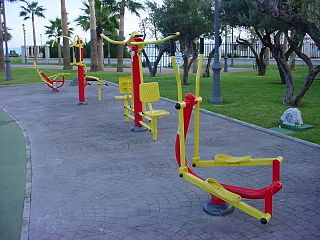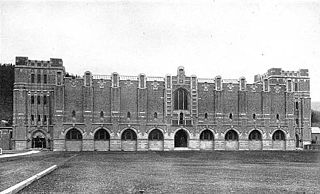
Calisthenics or callisthenics (/ˌkælɪsˈθɛnɪks/) is a form of strength training that utilizes an individuals body weight as resistance to perform multi-joint, compound movements with little or no equipment.

The gymnasium in Ancient Greece functioned as a training facility for competitors in public games. It was also a place for socializing and engaging in intellectual pursuits. The name comes from the Ancient Greek term gymnós, meaning "naked" or "nude". Only adult male citizens were allowed to use the gymnasia.

The German School of Budapest - Thomas Mann Gymnasium is a private international school in Budapest, Hungary. It was founded in 1908 to serve German families in Hungary. It now has a diverse student body with primarily children of the expatriate business and diplomatic communities. Considered to be one of the best schools of its kind, it was awarded a Certificate of Excellence by the Central Agency for German Schools Abroad in 2012 and again in 2020.

Kathryn Chicone Ustler Hall is a historic building on the campus of the University of Florida (UF) in Gainesville, Florida. It was designed by William Augustus Edwards in the Collegiate Gothic style and opened in 1919 as the University Gymnasium. In that capacity, the building was the first home of the Florida Gators men's basketball team, and it continued to serve as the home court for most of the university's indoor sports programs until the Florida Gymnasium opened in the late 1940s. The university became co-educational at about the same time, and the building was rechristened the Women's Gymnasium and was repurposed as a recreation center for the school's many new female students. On June 27, 1979, it was added to the U.S. National Register of Historic Places.

A health club is a place that houses exercise equipment for the purpose of physical exercise.

The Florida Gymnasium is a historic building located on the campus of the University of Florida (UF) in Gainesville. It opened in 1949 as a 7,000-seat multi-purpose arena and served as the home court of the Florida Gators men's basketball team and other UF indoor sports programs for over thirty years, acquiring the nickname of "Alligator Alley" during that time.

Memorial Gymnasium is a 2,500-seat multi-purpose arena in Charlottesville, Virginia. It opened in 1924. It replaced Fayerweather Gymnasium as home to the University of Virginia Cavaliers basketball team until University Hall opened in 1965.

The Charles T. Woollen Gymnasium was the home of North Carolina Tar Heels men's basketball team from January 2, 1939, through February 27, 1965, across twenty-six seasons. Due to increased demand for viewing the varsity basketball team and limited capacity at then home court the Tin Can, school president Frank Porter Graham and Charles T. Woollen requested public funds for a new gymnasium and women's dormitory. After being rejected at the federal level, the North Carolina Public Works would award a grant of $283,090 to build a new gymnasium and the school would have to fundraise to cover the cost's remainder. The plans for the building included multi–level building that included an attached swimming pool, along with a main lobby that would overlook the main gymnasium area. Aside from varsity basketball, the building was used for physical education classes, recreational activity for students, and office spaces. Construction stretched from 1937 to 1938 and, upon completion, was seen as "modern" and one of the highest–quality basketball facilities in the Atlantic Coast Conference.

An outdoor gym is a gym built outside in a public park, with the all-weather construction of its exercise machines somewhat modeled on playground equipment. It is similar to the 1960s–1970s proliferation of fitness trails, which continue to be created particularly in the US and Europe. In some instances, trails used for fitness are referred to as outdoor gyms.

Herron Gymnasium was a gymnasium and classroom building on the Miami University campus in Oxford, Ohio. Later known as Van Voorhis Hall, it was listed in the National Register of Historic Places in November 1979. Originally conceived in 1893, it was constructed in 1897 and named for John W. Herron, a Miami alumnus and Cincinnati judge. It was Miami University's first gymnasium, and would serve as the main recreational center until the construction of Withrow Court in 1932, which led Herron to become a women's gym. Except for an interlude during World War II when it served as a Navy barracks, it served as a women's gym until the construction of "New Herron" in 1962. In the late 20th century its use diminished to AFROTC and men's intramural sports, and the gymnasium was demolished in 1986 and replaced with a parking lot.
A fitness boot camp is a type of group physical training program that may be conducted by gyms, personal trainers or other organizations. These programs are designed to build strength and fitness through a variety of types of exercise. The activities and format may be loosely modeled on aspects of fitness training used in the military and the trainers themselves may be former military personnel.

Helsinki Swimming Stadium is an outdoor swimming venue in Helsinki, Finland, located in the Eläintarha area to the northeast of the Helsinki Olympic Stadium.
"Chicken Fat" is a 1962 song written by Broadway composer Meredith Willson and performed by actor/singer Robert Preston. It was commissioned as part of the President's Council on Physical Fitness.

Outdoor recreation or outdoor activity refers to recreation done outside, most commonly in natural settings. The activities that encompass outdoor recreation vary depending on the physical environment they are being carried out in. These activities can include fishing, hunting, backpacking, walking and horseback riding — and can be completed individually or collectively. Outdoor recreation is a broad concept that encompasses a varying range of activities and landscapes.

Hayes Gymnasium, completed in 1910, is the oldest section of the current Arvin Cadet Physical Development Center at the United States Military Academy. Originally built as an independent structure to replace the academy's previous Richard Morris Hunt-built gymnasium which had served between 1891 and 1910, it was part of a large contract bid awarded to the Boston architectural firm of Cram, Goodhue, & Ferguson in 1903.

A gym, short for gymnasium, is an indoor venue for exercise and sports. The word is derived from the ancient Greek term "gymnasion". They are commonly found in athletic and fitness centers, and as activity and learning spaces in educational institutions. "Gym" is also slang for "fitness centre", which is often an area for indoor recreation. A "gym" may include or describe adjacent open air areas as well. In Western countries, "gyms" often describe places with indoor or outdoor courts for basketball, hockey, tennis, boxing or wrestling, and with equipment and machines used for physical development training, or to do exercises. In many European countries, Gymnasium also can describe a secondary school that prepares students for higher education at a university, with or without the presence of athletic courts, fields, or equipment.
The Anteater Recreation Center (ARC) is an 89,000-square-foot (8,300 m2) indoor gym facility that is part of campus recreation at the University of California, Irvine (UCI); the anteater is the mascot of the UC Irvine athletics team. It is open to all UCI students, faculty and staff members, alumni, and other university affiliates, including spouses.

Fitness culture is a sociocultural phenomenon surrounding exercise and physical fitness. It is usually associated with gym culture, as doing physical exercises in locations such as gyms, wellness centres and health clubs is a popular activity. An international survey found that more than 27% of world total adult population attends fitness centres, and that 61% of regular exercisers are currently doing "gym-type" activities. Getting and maintaining physical fitness has been shown to benefit individuals' inner and outer health. Fitness culture has become highly promoted through modern technology and from the rising popularity of social media platforms.

Bartlett Gymnasium is a former athletic facility on the campus of the University of Chicago in Chicago, Illinois, United States, that has been converted into a campus dining hall.

Outdoor fitness consists of exercise undertaken outside a building for the purpose of improving physical fitness. It contrasts with exercise undertaken inside a gym or health club for the same purpose. The activity may be undertaken in a park, in the wilderness, or other outdoor location. The popularity of outdoor fitness grew rapidly in the second-half of the twentieth century and grew as a commercial consumer market in the twenty-first century.















